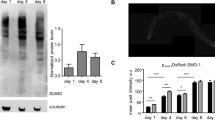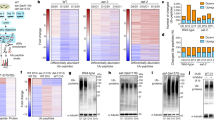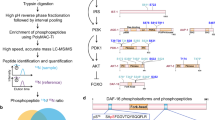Abstract
Regulation of protein synthesis is critical for cell growth and maintenance. Ageing in many organisms, including humans, is accompanied by marked alterations in both general and specific protein synthesis1. Whether these alterations are simply a corollary of the ageing process or have a causative role in senescent decline remains unclear. An array of protein factors facilitates the tight control of messenger RNA translation initiation2. The eukaryotic initiation factor 4E (eIF4E), which binds the 7-monomethyl guanosine cap at the 5′ end of all nuclear mRNAs, is a principal regulator of protein synthesis3. Here we show that loss of a specific eIF4E isoform (IFE-2) that functions in somatic tissues4 reduces global protein synthesis, protects from oxidative stress and extends lifespan in Caenorhabditis elegans. Lifespan extension is independent of the forkhead transcription factor DAF-16, which mediates the effects of the insulin-like signalling pathway on ageing. Furthermore, IFE-2 deficiency further extends the lifespan of long-lived age and daf nematode mutants. Similarly, lack of IFE-2 enhances the long-lived phenotype of clk and dietary-restricted eat mutant animals. Knockdown of target of rapamycin (TOR), a phosphatidylinositol kinase-related kinase that controls protein synthesis in response to nutrient cues, further increases the longevity of ife-2 mutants. Thus, signalling via eIF4E in the soma is a newly discovered pathway influencing ageing in C. elegans.
This is a preview of subscription content, access via your institution
Access options
Subscribe to this journal
Receive 51 print issues and online access
$199.00 per year
only $3.90 per issue
Buy this article
- Purchase on Springer Link
- Instant access to full article PDF
Prices may be subject to local taxes which are calculated during checkout




Similar content being viewed by others
References
Ward, W. F. The relentless effects of the aging process on protein turnover. Biogerontology 1, 195–199 (2000)
Gebauer, F. & Hentze, M. W. Molecular mechanisms of translational control. Nature Rev. Mol. Cell Biol. 5, 827–835 (2004)
Gingras, A. C., Raught, B. & Sonenberg, N. eIF4 initiation factors: effectors of mRNA recruitment to ribosomes and regulators of translation. Annu. Rev. Biochem. 68, 913–963 (1999)
Keiper, B. D. et al. Functional characterization of five eIF4E isoforms in Caenorhabditis elegans. J. Biol. Chem. 275, 10590–10596 (2000)
Amiri, A. et al. An isoform of eIF4E is a component of germ granules and is required for spermatogenesis in C. elegans. Development 128, 3899–3912 (2001)
Beanan, M. J. & Strome, S. Characterization of a germ-line proliferation mutation in C. elegans. Development 116, 755–766 (1992)
Kenyon, C. The plasticity of aging: insights from long-lived mutants. Cell 120, 449–460 (2005)
Lakowski, B. & Hekimi, S. Determination of life-span in Caenorhabditis elegans by four clock genes. Science 272, 1010–1013 (1996)
Lakowski, B. & Hekimi, S. The genetics of caloric restriction in Caenorhabditis elegans. Proc. Natl Acad. Sci. USA 95, 13091–13096 (1998)
Waskiewicz, A. J. et al. Phosphorylation of the cap-binding protein eukaryotic translation initiation factor 4E by protein kinase Mnk1 in vivo. Mol. Cell. Biol. 19, 1871–1880 (1999)
Vellai, T. et al. Genetics: influence of TOR kinase on lifespan in C. elegans. Nature 426, 620 (2003)
Ruvinsky, I. & Meyuhas, O. Ribosomal protein S6 phosphorylation: from protein synthesis to cell size. Trends Biochem. Sci. 31, 342–348 (2006)
Arquier, N., Bourouis, M., Colombani, J. & Leopold, P. Drosophila Lk6 kinase controls phosphorylation of eukaryotic translation initiation factor 4E and promotes normal growth and development. Curr. Biol. 15, 19–23 (2005)
Reiling, J. H., Doepfner, K. T., Hafen, E. & Stocker, H. Diet-dependent effects of the Drosophila Mnk1/Mnk2 homolog Lk6 on growth via eIF4E. Curr. Biol. 15, 24–30 (2005)
Jia, K., Chen, D. & Riddle, D. L. The TOR pathway interacts with the insulin signaling pathway to regulate C. elegans larval development, metabolism and life span. Development 131, 3897–3906 (2004)
Proud, C. G. Regulation of mammalian translation factors by nutrients. Eur. J. Biochem. 269, 5338–5349 (2002)
Martin, G. M., Austad, S. N. & Johnson, T. E. Genetic analysis of ageing: role of oxidative damage and environmental stresses. Nature Genet. 13, 25–34 (1996)
Stadtman, E. R. Protein oxidation and aging. Science 257, 1220–1224 (1992)
Lin, S. J. & Culotta, V. C. The ATX1 gene of Saccharomyces cerevisiae encodes a small metal homeostasis factor that protects cells against reactive oxygen toxicity. Proc. Natl Acad. Sci. USA 92, 3784–3788 (1995)
Yoshikawa, S. et al. Redox-coupled crystal structural changes in bovine heart cytochrome c oxidase. Science 280, 1723–1729 (1998)
Vanfleteren, J. R. Oxidative stress and ageing in Caenorhabditis elegans. Biochem. J. 292, 605–608 (1993)
Sohal, R. S. & Weindruch, R. Oxidative stress, caloric restriction, and aging. Science 273, 59–63 (1996)
Ishii, N. et al. A mutation in succinate dehydrogenase cytochrome b causes oxidative stress and ageing in nematodes. Nature 394, 694–697 (1998)
Tavernarakis, N., Wang, S. L., Dorovkov, M., Ryazanov, A. & Driscoll, M. Heritable and inducible genetic interference by double-stranded RNA encoded by transgenes. Nature Genet. 24, 180–183 (2000)
Makrides, S. C. Protein synthesis and degradation during aging and senescence. Biol. Rev. Camb. Philos. Soc. 58, 343–422 (1983)
Rattan, S. I. Synthesis, modifications, and turnover of proteins during aging. Exp. Gerontol. 31, 33–47 (1996)
Tavernarakis, N. & Driscoll, M. Caloric restriction and lifespan: a role for protein turnover? Mech. Ageing Dev. 123, 215–229 (2002)
Ruggero, D. et al. The translation factor eIF-4E promotes tumor formation and cooperates with c-Myc in lymphomagenesis. Nature Med. 10, 484–486 (2004)
Ahmed, S. & Hodgkin, J. MRT-2 checkpoint protein is required for germline immortality and telomere replication in C. elegans. Nature 403, 159–164 (2000)
Kirkwood, T. B. & Austad, S. N. Why do we age? Nature 408, 233–238 (2000)
Pan, K. Z. et al. Inhibition of mRNA translation extends lifespan in C. elegans. Ageing Cell doi:10.1111/j.1474-9726.2006.00266.x (5 December 2006).
Hansen, M. et al. Lifespan extension by conditions that inhibit translation in C. elegans. Ageing Cell doi:10.1111/j.1474-9726.2006.00267.x (5 December 2006).
Acknowledgements
We are grateful to A. Pasparaki, H. Kontaki, N. Kourtis and M. Papadakis for help with experiments. We thank M. Artal-Sanz and G. Thireos for comments on the manuscript. Some nematode strains used in this work were provided by the C. elegans Gene Knockout Project at OMRF (http://www.mutantfactory.ouhsc.edu/), which is part of the International C. elegans Gene Knockout Consortium, and the Caenorhabditis Genetics Center, which is funded by the NIH National Center for Research Resources (NCRR). We thank A. Fire for plasmid vectors. This work was funded by grants from EMBO and the EU sixth Framework Programme to N.T. N.T. is an EMBO Young Investigator.
Author Contributions P.S., K.T and N.T. performed experiments; N.T designed experiments, analysed data and wrote the manuscript. All authors discussed the results and commented on the manuscript.
Author information
Authors and Affiliations
Corresponding author
Ethics declarations
Competing interests
Reprints and permissions information is available at www.nature.com/reprints. The authors declare no competing financial interests.
Supplementary information
Supplementary Informtaion
This file contains Supplementary Materials and Methods, Supplementary Tables 1-2, Supplementary Figures 1-4 with Legends and additional references. (PDF 308 kb)
Rights and permissions
About this article
Cite this article
Syntichaki, P., Troulinaki, K. & Tavernarakis, N. eIF4E function in somatic cells modulates ageing in Caenorhabditis elegans. Nature 445, 922–926 (2007). https://doi.org/10.1038/nature05603
Received:
Accepted:
Published:
Issue Date:
DOI: https://doi.org/10.1038/nature05603
This article is cited by
-
Targeting the biology of aging with mTOR inhibitors
Nature Aging (2023)
-
Early-adulthood spike in protein translation drives aging via juvenile hormone/germline signaling
Nature Communications (2023)
-
Geroprotective interventions in the 3xTg mouse model of Alzheimer’s disease
GeroScience (2023)
-
ATF-4 and hydrogen sulfide signalling mediate longevity in response to inhibition of translation or mTORC1
Nature Communications (2022)
-
Mitochondrial maturation drives germline stem cell differentiation in Caenorhabditis elegans
Cell Death & Differentiation (2020)
Comments
By submitting a comment you agree to abide by our Terms and Community Guidelines. If you find something abusive or that does not comply with our terms or guidelines please flag it as inappropriate.



